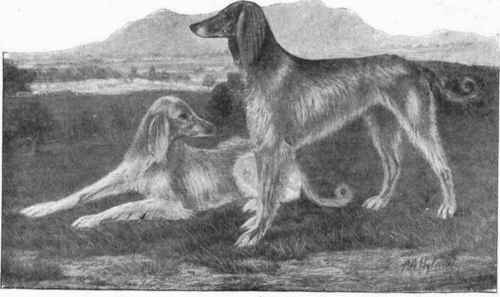The Barukhzy (Afghan) And Allied Eastern Hounds
Extract from "British Dogs, Their Points, Selection, And Show Preparation", by W. D. Drury 1903
Description
Belonging to the interesting Greyhound family, but approximating more closely to the Deerhound than to the Greyhound proper, is a curious-looking hound sometimes found in this country under the name of Afghan Greyhound, but more correctly by the name adopted above. After the Afghanistan War several of these hounds were brought to England, and occasionally the Foreign Dog classes at our shows were enriched by an entry of one. Mr. Carter, of Carshalton, had one specimen that was frequently benched - Rajah II. by name; while another was Motee, owned by Mr. Tufnell. Rajah II. was a very active dog, and lived to a good old age. He was a fawn, merging into red on the back. His coat was abundant, but fine in texture; while the dog was feathered on flank, breast, tail, and legs. The ears of the Barukhzy Hound are large and pendulous, and covered with wavy hair some 5m. or 6in. long. In the bitches especially there are tufts of hair on the loins; while there is a fringe of curly hair as a sort of topknot.
To judge by the general appearance of the Barukhzy Hound, one feels inclined to write it down as a soft, timid animal. This, however, is far from being the case. Some six years ago we received from Major Mackenzie a most interesting contribution upon these hounds, and in that the dog is described as bold and courageous to a degree. Moreover, the writer was speaking not only of a very large number that he had kept while residing in Switzerland, but also of the hound as found in Afghanistan.
Major Mackenzie thus writes: "The sporting dog of Afghanistan, sometimes called the Cabul Dog, has been named the Barukhzy Hound from being chiefly used by the sporting sirdars of the royal Barukhzy family. It comes from Balkh, the north-eastern province of Afghanistan, where it is believed that dogs of this variety entered the ark with Noah. That it is an old variety (probably the oldest domesticated breed in existence) is proved by very ancient rock-carvings, within caves of Balkh, of dogs exactly like the Barukhzy Hound of to-day. On some of these carvings, of colossal size, are inscriptions of much later date, that were written by invaders under Alexander the Great."
To show what courage these hounds possess, Major Mackenzie relates how Koosh, the grandsire of the bitch Khulm (illustrated in "Practical Kennel Management"), alone killed a nearly full-grown leopard that was carrying away her dam Mooroo II., when she was a pup. The bitches, being kept in seclusion by the women (as carefully guarded as mares are in Arabia) except when required to hunt, are very shy. They usually hunt in couples, bitch and dog. The bitch attacks the hinder parts, and while the quarry is thus distracted, the dog, which has great power of jaw and neck, seizes and tears the throat. Their scent, speed, and endurance are remarkable; they track or run to sight equally well. Their long toes, being carefully protected by tufts of hair, are serviceable on both sand and rock. Their height varies from 24 in. to 30m. ; their weight from 451b. to 7olb. Usually they are of fawn or of bluish-mouse colour, but always of a darker shade on the back, which is smooth and velvety. The Shah owned a well-known dog of this variety, named Muckmul, meaning "velvet."
Barukhzy Hounds Muckmul and Mooroo ! II.
Fig. 39. - Barukhzy Hounds Muckmul and Mooroo II.

Some authorities are inclined to regard this hound as but a sub-variety of the Persian Greyhound - a dog that varies much as to coat character. Specimens of this graceful variety are comparatively rare in England. The Persian Greyhound is of similar type to our Greyhound, but more slimly built, and wanting the great muscular development that the latter possesses. These dogs differ from our Greyhounds also in having the ears larger, drooping, and heavily feathered. The fore-legs, thighs, and tail are also well fringed. The coat is somewhat silky in texture, and not so abundant upon the back and at the sides.
These hounds are employed in hunting the gazelle, an interesting account of which sport appeared in the Field some years ago. For this purpose they are used in relays, a custom that at one time obtained in this country in deer-hunting.
The Rampur Hound, a hairless dog, built on general Greyhound lines, but heavier, and with large, close drop, filbert-shaped ears, does not often occur at shows in this country. Those who have studied most carefully the dogs of India think that the Rampur Hound is but a modification of the Persian Greyhound. Anyhow, so far as India is concerned, it is one of the most useful dogs known, especially when crossed, as it frequently is, with our Greyhound. The produce is a dog capable of withstanding the heat without going to pieces on the hard ground.
The Rampur Hound is not so fast as its English relative the Greyhound, and, like all the members of the family indigenous to the East, it is inclined to "run cunning." It is a pity that the dog-loving public is not often familiarised with these Eastern hounds - the Persian Greyhound and the Barukhzy Hound especially - as -they are built on far more graceful lines than the coarser Rampur Hound.
W. D. Drury 1903
.
Related content:
The Hyland Painting
The Origins Section
Robert Leighton on Mrs Amps Ghazni 1926
UK - KAF (Bell Murray) Afghan Hounds, A Croxton Smith,
Country Life 1926 (extract)
Extract on The Afghan Hound from "The Practical Dog Book by Edward C Ash m.r.a.c (Dip. Hons.) 1931
Library Of Articles/Main Menu Toolbar
|
